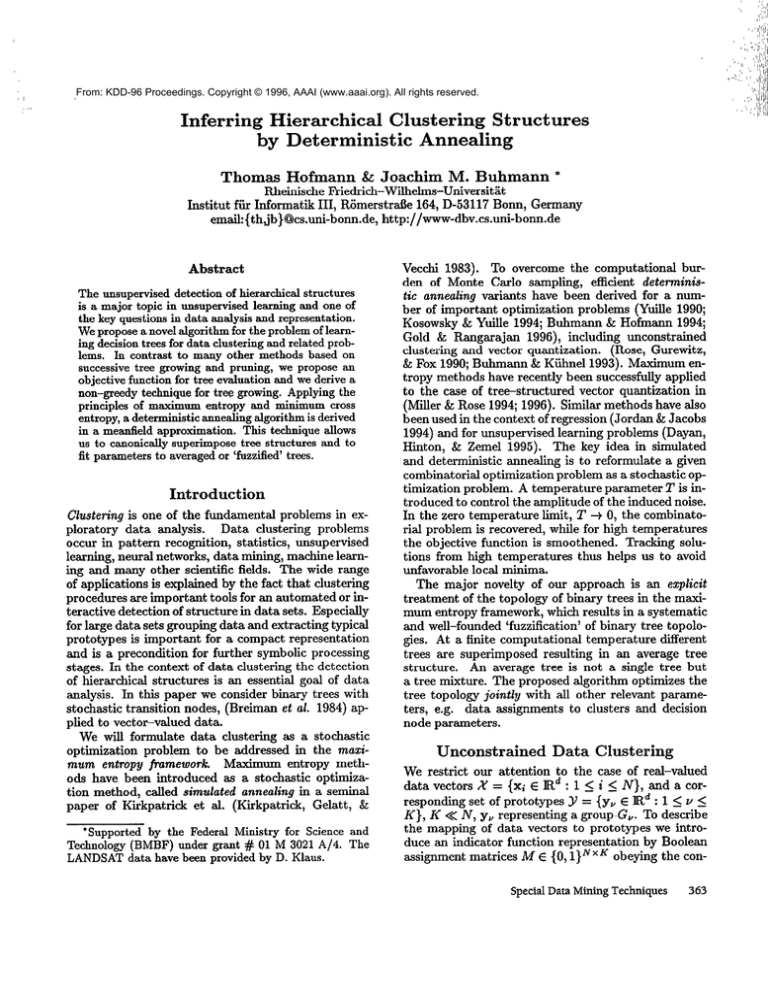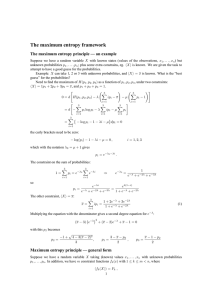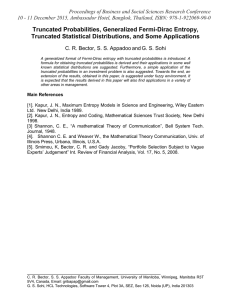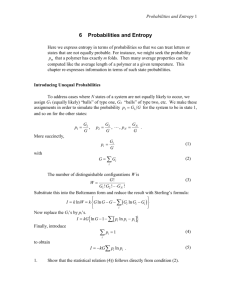
From: KDD-96 Proceedings. Copyright © 1996, AAAI (www.aaai.org). All rights reserved.
Inferring
Hierarchical
Clustering
Structures
by Deterministic
Annealing
Thomas
Hofmann
& Joachim
M. Buhmann
*
Rheinische F’riedrich-Wilhehns-UniversitZt
Institut fiir Informatik III, Riimerstra8e 164, D-53117 Bonn, Germany
email!(thjb)@cs,ur?i-bonn.de;
http://www-dbv.cs.uni-bonn.de
Abstract
The unsupervised detection of hierarchical structures
is a major topic in unsupervised learning and one of
the key questions in data analysis and representation.
We propose a novel algorithm for the problem of learning decision trees for data clustering and related problems. In contrast to many other methods based on
successive tree growing and pruning, we propose an
C.-e hM
selrl WP
clP~iVc=
,aL”G.,P
4Lnrt;nn
“YJ~~“‘.U
&UYI”I”Y
A”.
“III
”,a~“lr,lt;n”
.uIUYYIVY -..
. . u x.1*.
. u Y1
non-greedy technique for tree growing. Applying the
principles of maximum entropy and minimum cross
entropy, a deterministic annealing algorithm is derived
in a meanfield approximation. This technique allows
us to canonically superimpose tree structures and to
fit parameters to averaged or ‘fuzzified’ trees.
Introduct
ion
Clustering is one of the fundamental problems in exData clustering problems
ploratory data analysis.
occur in pattern recognition, statistics, unsupervised
learning, neural networks, data mining, machine learning and many other scientific fields. The wide range
of applications is explained by the fact that clustering
procedures are important tools for an automated or interactive detection of structure in data sets. Especially
for large data sets grouping data and extracting typical
prototypes is important for a compact representation
and is a precondition for further symbolic processing
stages. In the context of data clustering the detection
of hierarchical structures is an essential goal of data
analysis. In this paper we consider binary trees with
stochastic transition nodes, (Breiman et al. 1984) applied to vector-valued data.
We will formulate data clustering as a stochastic
optimization problem to be addressed in the masimum entropy framework.
Maximum entropy methods have been introduced as a stochastic optimization method, called simulated annealing in a seminal
paper of Kirkpatrick
et al. (Kirkpatrick,
Gelatt, &
*Supported by the Federal Ministry for Science and
Technology (BMBF) under grant # 01 M 3021 A/4. The
T hhTnC*m Uaba
-1-L.. l.UILVC:
^_.^ La-:,l,2 l.,..
JAfiIYU3tll.
“CGU-_-_.
yr”“ru.aa
“y nU. E-1....,
L\lauu*
Vecchi 1983). To overcome the computational burden of Monte Carlo sampling, efficient deterministic anne&ng variants have been derived for a number of important optimization problems (Yuille 1990;
Kosowsky & Yuille 1994; Buhmann & Hofmann 1994;
Gold & Rangarajan 1996), including unconstrained
clustering and vector quantization.
(Rose, Gurewitz,
& Fox 1990; Buhmann & Kiihnel1993).
Maximum entropy methods have recently been successfully applied
to the case of tree-structured
vector quantization in
(Miller & Rose 1994; 1996). Similar methods have also
been used in the context of regression (Jordan & Jacobs
1994) and for unsupervised learning problems (Dayan,
Hinton, & Zemel 1995). The key idea in simulated
and deterministic annealing is to reformulate a given
combinatorial optimization problem as a stochastic optimization problem. A temperature parameter T is introduced to control the amplitude of the induced noise.
In the zero temperature limit, T + 0, the combinatorial problem is recovered, while for high temperatures
the objective function is smoothened. Tracking soiutions from high temperatures thus helps us to avoid
unfavorable local minima.
The major novelty of our approach is an explicit
treatment of the topology of binary trees in the maximum entropy framework, which results in a systematic
and well-founded ‘fuzzification’ of binary tree topologies. At a finite computational temperature different
trees are superimposed resulting in an average tree
structure.
An average tree is not a single tree but
a tree mixture. The proposed algorithm optimizes the
tree toooioor iointly with all other relevant parann!ters, e.g. data assignments to clusters and decision
node parameters.
Unconstrained
Data
Clustering
We restrict our attention to the case of real-valued
data vectors X = {xi E lRd : 1 5 i s N}, and a corresponding set of prototypes Y = {yv E IRd : 1 5 Y 5
K}, K << N, yy representing a group-G,. To describe
the mapping of data vectors to prototypes we introduce an indicator function representation by Boolean
no&-rn.-.-ent IIIU”II\-cu
m.ztv.;raa a.*
it/i Lc In
nhmr;nu +~-,a
VA&..t-n,,
-“AAWO1~111~1L.11”
I”, ‘IJV”xK “V”J*1*~
Special Data Mining Techniques
363
straints Cr=‘=, Mj, = 1, for all i. The objective function for unconstrained data clustering is usually stated
as (Duda & Hart 1973)
N
K
i=l v=l
where I? is a problem dependent distortion measure,
e.g. D(xi,y,)
= ]/xi - ~~11”. Applying the principle of maximum entropy, Boolean assignments are replaced by assignment probabilities (Mi,), maximizing
the entropy S = - Cz
Cf=‘=, (Mi,) log(it&,) subject
to fixed expected costs t ‘tl). For a given set of prototypes the assignment probability of vector x; to group
G, is the Gibbs distribution
exp[-WG Y~)/TMI
(2)
C,“=,exp[-WG, Y~)/TMI’
(*@iv> c
where TM is the computational temperature.
Minimization of the expected costs with respect to the prototype vectors results in an additional set of centroid
equations,
YV
=
&Miv)*i
i=l
/ g(“iV),
i=l
(3)
for the case of squared Euclidean distances. Eqs. (2)
and (3) can be solved efficiently by an EM algorithms
(Dempster, Laird, & Rubin 1977). In a more general
situation additional prior assignment probabilities OTT;,
are given. Applying the principle of minimum cross entropy this results in modified, ‘tilted’ assignment probabilities,
which minimize the cross entropy to the prior for fixed
costs (3-1) ((Miller & Rose 1994)). For uniform priors,
we recover Eq. (2) as expected. Tilted assignments will
be used in the following section to model the influence
of the cluster hierarchy on data assignments.
n,, respectively. X, controls the stochasticity of the
transition, hard decision boundaries are obtained for
X, -+ co. The path probability x7(x) of a data vector
x from the root to a node ny is given by the product of all transition probabilities at inner nodes on
that path. in the liiit
of di A, -b 00 the tree defines a unique partitioning of the data space. Following (Miller & Rose 1996) we optimize the tree in order to minimize the deviation of the decision tree data
partitioning from an unconstrained clustering solution
with assignment probabilities {(Miv)}.
As a suitable
measure of divergence between probabilities the crossentropy or KuIlback-Leibler divergence is employed,
z({(Mv)}ll{~iv))
Trees for Data
Clustering
In this paper we consider stochastic binary decision
trees with a given number of K leaves, representing
the data clusters. We denote nodes of the tree by
n,, 0 5 a 5 2K - 2. Associated with each inner
node n, are two test vectors yk,yL E lRd and a control parameter X, E IR+. The test vectors determine
transition probabilities p&(x) and &(x)
for a given
vector x according to the formula
exp [-&3(x,
p’p(x)
= exp [-X,2>(x,
y?‘)]
yk)] + exp [-X,z)(x,
y;)] ’ (5)
p;(x) and p:(x) are the probability for vector x to
continue its path with the left and right successor of
364
Technology Spotlight
e,
(6)
where aj, = xv+K-s(xi).
The binary tree is optimized such that the leaf probabilities xiv approximate as closely as possible the target probabilities.
Conversely, for a given tree the prototype vectors
Y are selected to minimize the exnected distortion
k(Y, {xiv}) = CL1 Cf=‘=,(Miv)?r -D(w, YY), where
(Mi,)” is the tilted distribution from Eq. (4). The
path-probabilities obtained from the tree take the role
of a prior to impose structural constraints on the selection of prototypes.
Since our goal is to explicitly optimize the tree topology, we introduce an adjacency matrix re resentation
for binary trees. Let U’, Up E (0, l}tK-r Px(2K-11 encode the successor relation between nodes in the tree.
u wl/r = 1 denotes that n, is the immediate left/right
successor of inner node no. To avoid directed cycles
we use the node numbering as a total order, where
successing nodes are required to have a higher index.
Furthermore every inner node has exactly one left and
one right successor and all nodes except the root ns are
required to have a unique predecessor. The path probabilities x7(x) are related to the adjacency matrices by
tile formula.
+>
Decision
= 2 E(Miv)lOg
i=l v=l
7-l
= c 744
[C,
PS>
+ U& PLMI
9 (7)
a=0
with TO(X) = 1. Path probabilities are efficiently calculated by sequentially propagating the probabilities
from the root to the leaf nodes. This results in a welldefined optimization problem with a single objective
function for the tree topology encoded by U’, U’ and
all involved continuous decision node parameters.
Optimizing
the ‘iPee Topology
The problem of finding an optimal decision tree is computationally difficult for two reasons: (i) the number
of binary trees grows exponentially with the number of
leaves; (ii) evaluating the quality of a single topology
requires to fit all continuous parameters for test vectors and prototypes. The maximum entropy method
nfftwa
.,-“*”
at.nrhaatir
-9 y”.,u-~--
frzmwwrnrk
--*A-v.-aY
whi&*
rep-&s
~2~ zyep
age over tree topologies feasible. Parameters are fitted
not to a single tree, but to a weighted superposition
of structures which converges only in the zero temperature liiit
towards a uniquely determined topology.
This results in a ‘fuzzification’ of structures at finite
temperatures, which is gradually eliminated in an annealing process.
Consider an extension of the probabilistic partitioning model, such that not only the transitions are
stochastic, but also the successors of nrr are randomly
drawn from the set of nodes {nr,r
> a}.
This
means the connection between n, and ny, encoded
by VA,, Vi., is a random variable, with expectations
= (U&), respectively. The
probabiliti& have to be chosen such that ‘&a
q& =
&,a
q& = 1 in order to obtain a correct normalization. A class of probabilities which is of special interest
in this context are fair probability distributions. A fair
probability distribution possesses the additional property that every node except the root has the same average number of predecessor, i.e. czr’, (q& + q&) = 1,
for all 7 > 0. Fair probability distribution have the advantage, that the constraints on U’ and U’ are at least
fulfilled in the average. In the extended model we can
calculate path probabilities for x simply by replacing
the Boolean variables in Eq. (7) by their probabilities.
Applying the maximum entropy principle to the objective function in Eq. (6), we assign the Gibbs probabilities P(U’, U’) = $ exp [-Z(U’, Up)/Tu] to every
Z is a normalization constant
tree topology U’,V.
and TV a temperature (or Lagrange) parameter. Ideally, we would like to average tree topologies according
to the Gibbs distribution, without performing a tedious
Monte Carlo sampling of trees. A standard approximation technique to analytically calculate Gibbs averages
is the meanfield approximation. In the meanfield approximation we restrict the set of admissible probability distributions to distributions Q which are factorial
and fair. Within this restricted set we want to pick
a Q* which maximizes the entropy for fixed expected
costs or equivalently minimizes the cross entropy to the
true Gibbs distribution Z (QIIP).
Omitting the technical details, the link probabilities
q$ of Q* are 0 for cx 2 7 and are otherwise given by
d, =’cvL>andqrr,
&ae
~QQC-
51~
Sinkhnm’
s
L-- -^--^--
(Sinkhnm
\‘-- -----1---
lCI64r
----,
and insert into Eq. (8), until a stationary state
is reached.
This is similar to the application of
Sinkhorn’s algorithm for graph matching problems
(Gold & Rangarajan 1996).
Fitting
Continuous
Tree Parameters
The continuous decision node parameters axe chosen
in order to minimize 1. Applying the chain rule in
calculating derivatives yields the final formula
az
= -2X, (Xj - yyp) [Sy’(Xi)
ayL!
-Pfil’(Xi)
(Sfi(Xi) + @ i,)]
?
(10)
where #(xi)
denotes up-propagated unconstrained
leaf probabilities. The test vectors can be optimized by
gradient methods, e.g. steepest descent or conjugate
gradient techniques. The derivation of similar equations for the control parameters X, is straightforward.
The optimization of prototype vectors yV proceeds
according to the centroid condition in Eq. (3), with the
unconstrained assignment probabilities replaced by the
‘tilted’ probabilities of Eq. (4). The only remaining
variables are the temperature parameters TM and Tu,
. ..l..A-.
WUIUI
. ...* :e#...,c:.A..
a&c: 1bGLacr”r;ly
A-.“...,.“...4
U~L.Lvzaacx4
,.,,.-..A:,,..
cv”L”ruuqj
+I\ nIJ” Llll
__..“#.
apprv-
priate annealing schedule.
Tree Clustering
Algorithm
(TCA)
INITIALIZATION
choose yw, yp‘lr, iip randomly
chose (Miy)) (Vet) E (0,l) randomly;
temperature TM t TO,T~Ji- CTM ;
WHILE TM > TFINAL
REPEAT
estimate tilted
assignm. {(Mu)},
Eq. (4)
update prototypes {yy} with tilted
assignm.
caic . unconstr.
assignm.
{(li4ii.jj, Eq. izj
adapt {yy’} and {A,} by gradient descent
apply Sinkhorn’s algorithm to talc. (a$}
UNTIL all
The above cross entropy minimization problem has
been reduced to the problem of finding values for the
Lagrange parameters P-,, such that Q is fair. Standard methods from combinatorial optimization, developed in the context of matching problems, can be applied to find solutions for Eq. (8) if all h$ are kept
fixed. In our simulations we used an iterative proce-
I a.llmrit.hm
-ol-‘”
-----
Kosowsky & Yuille 1994). To give the basic idea, the
Lagrange parameter P-, can be interpreted as the ‘price’
of linking n., to another node na. These prices have to
be simultaneously adjusted, such that every node has
in the average exactly one predecessors. To arrive at a
final solution we recalculate the derivatives
TM ~-TM/Z;
{yy}, {~a’}, {A,)
Try i- CTM;
are stationary
Results
The tree clustering
algorithm
can in principle
be ap-
plied to any set of vector-valued data. As a test example we chose synthetic two-dimensional data and
Special Data Mining Techniques
365
meadows
Figure 1: Hierarchical clustering of artificial twodimensional data from 16 isotropic Gaussian modes.
Displayed are partitionings with K = 4,9 and K = 16
clusters.
real world data from multispectral LANDSAT images
with seven spectral channels. The results on the synthetic data at different levels are shown in Fig. 1, together with a representation of the final tree topology.
The obtained hierarchical data partitioning retrieves
the structure of the generating source. Fig. 2 shows
the hierarchical split of the LANDSAT data. Regions
which correspond to particular clusters are grey-scale
coded and can be identified with the help of external
information. The split between meadows and other areas occurs fist in our example. Further down in the
hierarchy, a separation of forest from urban areas can
be observed. The hierarchy is stable for runs with different initial conditions.
References
Breiman, L.; FXedman, J. H.; Olshen, R. A.; and
Stone, C. J. 1984. Classification and Regression Trees.
Belmont, California: Wadsworth Intern. Group.
Buhmann, J., and Hofmann, T. 1994. A maximum
entropy approach to pairwise data clustering. In Proc.
Intern. Conf. on Pattern Recognition, Jerusalem, volume II, 207-212. IEEE Computer Society Press.
Buhmann, J., and Kiihnel, H. 1993. Vector quantiIT;rl?;lI;Im
^_^^ “+:m-,. “11
^_
A.:..- -24.L
----l^-:L-.
^^^A^ 1uJ2w
1~,w,csuL;m”IM
Z8blUll
Wlbll ~“lllp’
muby C;“SbS.
Information Theory 39(4):1133-1145,
Dayan, P.; Hinton, G.; and Zemel, R. 1995. The
Helmholtz machine. IVeunxI Computation 7(5):889904.
366
Technology Spotlight
Figure 2: Hierarchical clustering of a LANDSAT multispectral image with 7 channels. Hierarchical clustering reveals the underlying relationship between regions. Only the top levels of the tree are displayed.
Dempster, A. P.; Laird, N. M.; andRubin, D. B. 1977.
Maximum likelihood from incomplete data via the em
algorithm. J. Royal Statist. Sot. Ser. B 39:1-38.
Duda, R. O., and Hart, P. E. 1973. Pattern Cllassification and Scene Analysis. New York: Wiley.
Gold, S., and Rangarajan, A. 1996. A graduated as-T-~-----~-Aalgorlxnm
-sm.- -La for graph matching. 1333 pAi&.
signmem
in press.
Jordan, M., and Jacobs, R. 1994. Hierarchical mixtures of experts and the EM algorithm. Nearal Computation 6(2):181-214.
Kirkpatrick, S.; Gelatt, C.; and Vecchi, M. 1983. Optimization by simulated annealing. Science 220:671680.
Kosowsky, J., and Yuille, A. 1994. The invisble hand
algorithm: Solving the assignment problem with statistical physics. Neural Computation 7(3):477-490.
Miller, D., and Rose, K. 1994. A non-greedy approach to tree-structured clustering. Pattemt Recognition Letters 15(7):683-690.
Miller, D., and Rose, K. 1996. Hierarchical, unsupervised learning with growing via phase transitions. to
appear.
Rose, K.; Gurewitz, E.; and Fox, G. 1990. Statistical
mechanics and phase transition in clustering. Phy.
Rev. Lett. 65:945-948.
Sinkhorn, R. 1964. A relationship between arbitrary positive matrices and doubly stochastic matrices. Ann. Math. Statist. 35:876-879.
Yuille, A. 1990. Generalized deformable models, statistical physics, and matching problems. Neural Computation 2(1):1-24.







